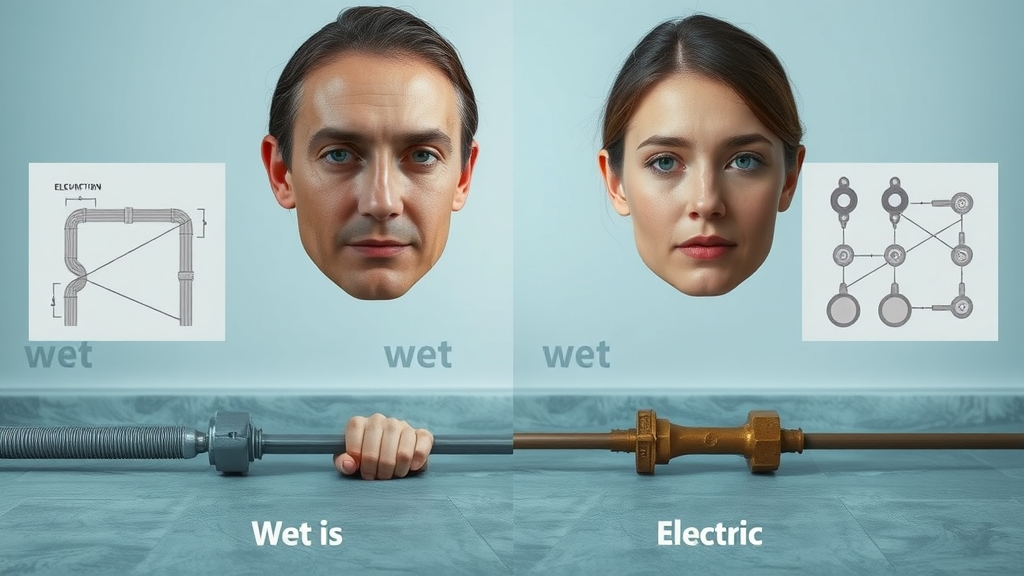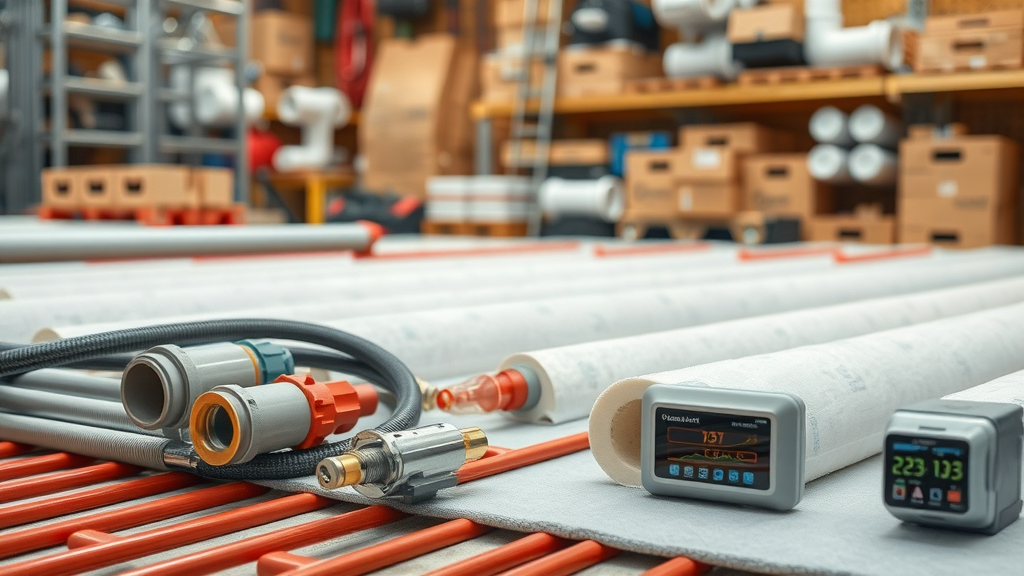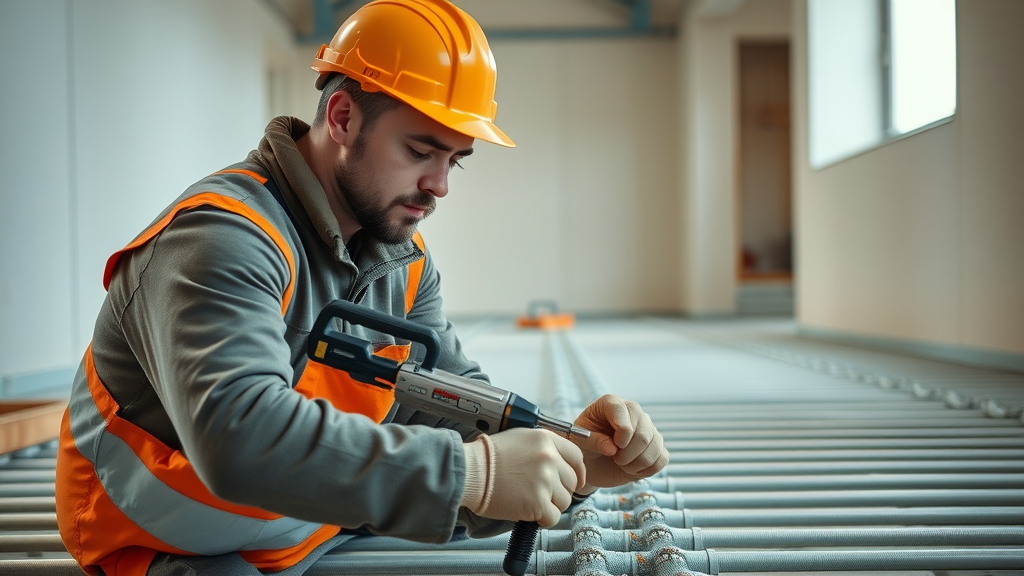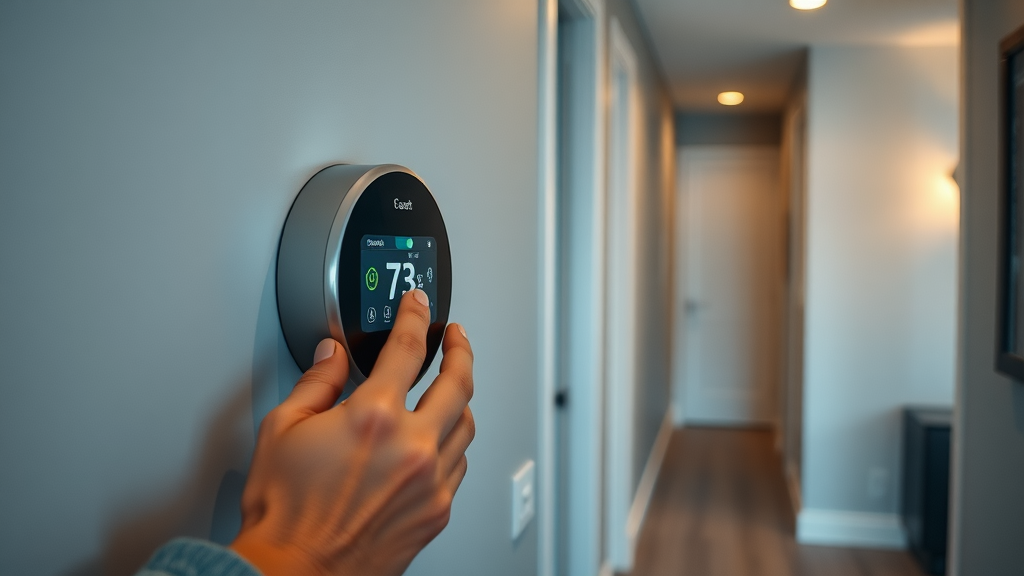Did you know? Recent studies show that professionally installed wet underfloor heating offers up to 30% greater energy efficiency compared to traditional radiators. While many homeowners are familiar with the cosiness of heated floors, few realise how much they stand to gain—both in comfort and in annual heating cost savings. In this article, we’ll break down the real cost to install a wet underfloor heating system, help you avoid hidden charges, and show you how underfloor heating puts you in control of your budget and your home’s comfort.
Unveiling the Real Cost to Install a Wet Underfloor Heating System: Why It Matters
Understanding the cost to install a wet underfloor heating system goes beyond simple numbers. It's about making a smart investment that brings comfort, value, and lasting savings to your home. Many property owners expect underfloor heating to be an extravagant luxury. In reality, with the right professional advice, it’s an affordable upgrade that can pay for itself through lower running costs and increased property appeal, especially in today's energy-conscious world.
The installation cost can vary depending on several factors, including whether you’re retrofitting an existing property or planning for a new build. Engaging a reputable installer such as Peak Underfloor Heating Ltd ensures you maximise benefits while minimising pitfalls. Investing now not only means enjoying evenly distributed warmth but also potentially a boost in your home’s market value. This guide will walk you through the ins and outs—with practical tips for every scenario.

"Recent studies show that professionally installed wet underfloor heating offers up to 30% greater energy efficiency compared to traditional radiators."
What You'll Learn About the Cost to Install a Wet Underfloor Heating System
Breakdown of wet underfloor heating installation costs
Factors influencing underfloor heating cost
Comparison of wet and electric underfloor heating systems
Analysis of running costs over time
Professional tips for budget-friendly installation
Introduction to Underfloor Heating Systems
Heated floors once felt like a rare luxury. But as energy prices rise and homeowners demand more efficient heating systems, underfloor heating is emerging as a go-to solution. At its core, underfloor heating transforms cold, uncomfortable floors into warmth that naturally rises, delivering consistent comfort throughout your living spaces. The growing popularity is due in part to the promise of lower heating costs and a more even distribution of heat compared to traditional systems.
When considering whether to install underfloor heating, it’s essential to understand the available types—wet and electric. Each system delivers unique advantages and comes with different upfront and ongoing costs. In the sections ahead, we’ll explore how wet underfloor heating stands out both for energy efficiency and for long-term savings, so you get the most value from your investment.
Types of Underfloor Heating: Wet vs Electric
There are two main types of system available: wet (water-based) and electric. Wet systems circulate heated water through pipes embedded within the floor, distributing warmth from the ground up. They are particularly effective in new builds or large, open spaces that require efficient heating. In contrast, electric underfloor heating uses electric cables or mats for rapid heat-up times, and is often preferred for small spaces or quick retrofits.
While the installation cost for electric underfloor heating is typically lower, wet underfloor heating systems boast far cheaper long-term running costs. Choosing which is best depends on your home’s construction, how you use your space, and your budget for both installation and ongoing heating costs.

How Wet Underfloor Heating Systems Work
A wet underfloor heating system works by pumping warm water through a network of pipes laid beneath your flooring. Connected to your boiler or a modern heat pump, the system maintains a steady, comfortable temperature, reducing the need for high water temperatures and increasing efficiency in the process.
This approach is gentler and more cost-effective than conventional central heating radiators. The slow, even emission of heat means fewer fluctuations in temperature, fewer cold spots, and reduced energy wastage. Combined with insulation, it means you stay warm for less, turning your investments into lasting comfort and substantial energy bill reductions.
Key Cost Factors to Install a Wet Underfloor Heating System
The total cost to install a wet underfloor heating system is influenced by several factors, each with its own role in your final budget. Let’s explore the main contributors: materials, labour, property size and type, and whether you’re tackling a new build project or retrofitting an older home.
These costs may seem daunting at first, but when understood and managed properly, they pave the way for comfort, lower running costs, and greater long-term value. Knowing where most of your budget goes will help you find smart ways to reduce your installation cost and get the most for your money—especially with advice from seasoned professionals.
Material Costs: Pipes, Manifolds, Insulation, and Controls
Material costs make up a large proportion of the overall underfloor heating cost. High-quality pipes, precision-engineered manifolds, robust insulation, and smart digital controls all contribute to the price. The type and quality of each component affect efficiency, longevity, and energy-saving potential. PEX or multi-layer composite pipes, for example, are valued for their durability and resistance to corrosion, while premium insulation ensures that your floor heating system directs warmth upwards rather than losing it to the subfloor.
On average, for a 100m² property, expect materials alone to range from £2,000 to £4,000. Smart thermostatic controls can add £200 to £500, but these enable zoned heating and precise energy management—often paying for themselves in reduced running costs. Remember: investing in better materials and controls now saves you from costly repairs and unnecessary heating bills later.

Labour Costs for Installing Underfloor Heating
Professional labour is a must when it comes to wet underfloor heating installation. Costs depend on project scope, local rates, and the complexity of your flooring. For seasoned fitters, rates typically run £30 to £50 per hour, with total installation times spanning several days, especially for larger or complex layouts.
Labour expenses can account for £2,000 to £6,000 for the same 100m² space. Opting for budget installers may save money upfront but can risk costly mistakes, leaks, or disappointing system performance. At Peak Underfloor Heating Ltd, highly trained engineers ensure seamless, code-compliant installation—saving you time and safeguarding your investment for years to come.
Project Size, Floor Construction, and Property Type
The installation cost will vary depending on the size of your area, the complexity of your floor structure, and whether your property is an open-plan new build or a segmented retro-fit. Open areas are generally quicker and less expensive to install due to fewer interruptions, while older properties with joists, multiple rooms, or uneven floors require more preparation and can drive costs upward.
Special considerations—like raising floors to accommodate new pipework or adding extra insulation in a draughty Victorian terrace—add time and materials. Consulting experts early in your planning ensures solutions are tailored to your property type, ultimately improving efficiency and reducing long-term heating costs.

New Build vs Retrofit: Installation Cost Differences
It’s typically less expensive to install wet underfloor heating in a new build than during a retrofit. In new construction, floor finishes haven’t yet been laid, and plumbing and layout can accommodate piping from the start, keeping material wastage and labour time to a minimum. Installations can be planned to coincide with other construction activities, making the process smooth and cost-efficient.
Retrofitting, on the other hand, often means lifting floors, rerouting existing pipes, increasing structural supports, or updating insulation. These tasks increase complexity and can push up overall project costs. While new builds can see installation from £50 to £80/m², retrofit projects may approach or even exceed £100/m², reflecting the additional labour and material requirements.
Installation Process & Timeline for Wet Underfloor Heating
A smooth, well-planned installation is vital for realising long-term savings. Let’s break down what to expect—from system design to the final warm-up.
Proper planning ensures minimal disruption and a finished product that delivers on comfort and efficiency. Knowing the timeline from the outset helps you coordinate with other trades and manage your expectations during home renovation or construction.
Step-by-Step Guide to Install a Wet Underfloor Heating System
1. Survey and design: Experts assess your home’s dimensions, insulation, and requirements, designing a bespoke system.
2. Floor preparation: Subfloors are inspected, cleaned, and insulation boards are laid to ensure heat moves upward.
3. Pipework installation: Skilled installers lay and secure PEX or multi-layer pipes in loops across the floor area.
4. Manifold and controls: Manifolds are mounted on walls and pipes connected; digital thermostats are programmed.
5. Screeding and finishing: Floors are screeded to encase pipes, then finished with your choice of flooring.
6. System testing: Pressure tests and filling ensure leak-free, efficient operation before the final handover.
Quality installation is key to achieving maximum efficiency from your underfloor heating. By using certified professionals and trusted brands, you ensure every stage meets safety, efficiency, and comfort standards—response times, reliability, and heating performance all become easier to predict and control.

Typical Installation Timeline for Floor Heating
For a standard 100m² area, the process can take between five days and two weeks, depending on complexity. New builds are usually on the quicker end, as fewer obstacles need addressing. Retrofits may take longer due to demolition, reinforcement, and custom fitting.
Transparency in quoting and scheduling is essential. Leading specialists clearly communicate all expected steps and keep closely to project milestones, minimising surprises. Homeowners can expect most of the installation time to be devoted to preparation (insulation, levelling, and subfloor work) and final finishing (screeding and drying), critical for system longevity.
Comparing Wet Underfloor Heating Cost with Other Heating Systems
Knowing how wet underfloor heating stacks up against electric underfloor heating and traditional central heating radiators is useful for informed decision-making. This comparison sheds light on both installation and running costs, affecting your home’s future heating bills and comfort.
Homeowners often wonder whether the upfront expense of installing underfloor heating translates into real-life financial benefits over time. In most cases—especially when professional installation is factored in—the answer is yes.
Wet Underfloor Heating vs Electric Underfloor Heating Costs
The upfront installation cost for wet underfloor heating tends to be higher than for electric systems, largely due to pipes, manifolds, and the need for more labour-intensive fitment. However, wet underfloor systems are generally cheaper to run in the medium to long term, especially in larger spaces or whole-home applications.
Electric underfloor heating shines in smaller spaces like bathrooms, where minimal work is needed, but ongoing running costs can outstrip wet systems, especially in properties with high electricity tariffs. Wet underfloor heating, when used with efficient boilers or a heat pump, delivers significant annual savings courtesy of lower water temperatures and a reduced electricity draw.
Underfloor Heating vs Central Heating Radiator Running Costs
Traditional central heating radiators lose more heat to their surroundings and require higher water temperatures to deliver warmth. This means boilers must work harder, increasing your heating costs year on year. Underfloor heating systems, by contrast, operate at much lower temperatures (typically 35–45°C compared to radiators’ 60–75°C), significantly cutting energy usage without sacrificing comfort.
The even heat distribution provided by underfloor systems removes the cold spots typical with radiators and can make rooms feel warmer at a lower thermostat setting, squeezing even more value from every pound you spend on heat.
Cost Comparison Table: Wet Underfloor, Electric Underfloor, and Traditional Radiators |
|||
System Type |
Installation Cost (Approx. per 100m²) |
Running Cost (Annual) |
Best For |
|---|---|---|---|
Wet Underfloor Heating |
£6,000–£10,000 |
£350–£600 |
Whole-house, high efficiency, new builds, major renovations |
Electric Underfloor Heating |
£3,000–£5,000 |
£800–£1,200 |
Small areas, quick bathroom or kitchen retrofits |
Central Heating Radiators |
£2,500–£4,500 |
£600–£1,000 |
Older homes, direct replacement of existing radiators |
Calculating the Running Costs of a Wet Underfloor Heating System
Once installed, your floor heating running costs become the star of the show. A well-designed wet underfloor system saves money every month by reducing energy consumption and keeping temperatures consistent. But how much can you expect to spend—and save—in a typical year?
Careful planning and use of energy-efficient components (such as a modern heat pump) or high-efficiency boiler make running costs even lower. Let’s look at how this plays out in practice.
Energy Efficiency and Heating Costs
Wet underfloor heating systems are famous for their remarkable energy efficiency. By working at lower temperatures and distributing warmth evenly, you save on fuel, reduce emissions, and enjoy a consistently comfortable home. In a standard 3-bedroom house, annual heating costs are commonly reduced by 15-30% compared to radiator heating, with well-insulated properties seeing even more dramatic savings.
The best results are achieved when underfloor heating is teamed up with a condensing boiler or, for maximum efficiency, a low-carbon heat pump. This smart collaboration further shrinks running costs compared to electric underfloor heating or a traditional radiator-based system, providing future-proof comfort at a price modern homeowners can afford.

How Usage, Insulation, and Heat Source Affect Running Costs
Just like any other system, your underfloor heating cost is influenced by your daily habits, the quality and thickness of your insulation, and your choice of heat source. Homes with upgraded insulation, double-glazed windows, and draught-proofing get dramatically better results. Similarly, properties fitted with renewable heat sources, such as heat pumps, see the lowest running costs—sometimes less than half those of homes using older, less efficient boilers.
The flexibility of modern controls means you only heat rooms when needed and at optimal times. Pairing your floor heating with smart thermostats or zoned control strategies ensures precise management, so you never spend more than necessary on comfort. The best systems are those that adapt to your lifestyle—not the other way around.
The Long-Term Value: Underfloor Heating Cost vs Return on Investment
Investing in wet underfloor heating is more than just a home upgrade—it’s a long-term strategy for lowering heating costs while enhancing daily life. Higher comfort levels, better air quality (thanks to reduced dust circulation), and modernised controls often translate to increased resale value and buyer appeal.
"Homeowners consistently report higher comfort and lower heating bills after switching to wet underfloor heating systems." – Peak Underfloor Heating Ltd
The combination of durability, low maintenance, and long-term savings makes the cost to install a wet underfloor heating system an investment in your property’s future as well as your family’s comfort and wellbeing.
Case Studies: Real-Life Cost to Install Wet Underfloor Heating
Case study 1: New build detached home installation
Case study 2: Retrofit in a Victorian terrace
Case Study 1: New Build Detached Home
A couple building a 150m² detached home chose wet underfloor heating throughout. Early planning made pipework integration easy and installation efficient. Total installed cost: £8,500, including premium digital controls. First-year bills dropped by 28% compared to friends’ similar-size homes with radiators. Future-proofed for heat pump upgrades.
Case Study 2: Retrofit in a Victorian Terrace
Owners of a 90m² Victorian home faced higher labour charges to lift floors and insulate. Their installation cost came in at £9,000 but annual bills are £400 less than before. Improved comfort and a step-change in energy efficiency have made their home far more attractive to prospective buyers.

Government Grants, Incentives, and Finance Options for Underfloor Heating
Upgrading your home’s heating system can be more affordable thanks to various government grants and incentive schemes. From the Boiler Upgrade Scheme to zero-VAT installations in sustainable new builds, it pays to explore what assistance is available for your region and property type.
Additional options include attractive finance packages offered by leading installers. Peak Underfloor Heating Ltd, for example, can help unlock funding to cover a portion of the installation cost, making high-efficiency underfloor heating accessible for more families than ever before.
Eligibility for Heat Pump and Underfloor Heating Installations
Many grant schemes prioritise energy-efficient heating, particularly when combined with modern heat pump technologies. If your property is well-insulated or is a new build, eligibility is even higher. A professional consultation—often free with reputable installers—will quickly determine what grants and support you may qualify for, smoothing the path to a warmer, greener home.
It’s always wise to start the process early, as grant deadlines change, and securing funding up front can help keep your project on budget and on schedule.

Expert Tips to Manage and Reduce the Cost to Install a Wet Underfloor Heating System
How to select reputable installers
Using smarter controls for lower running costs
Maintenance tips for maximising efficiency
Select the Right Installer: Seek installers who offer clear quotes, references, and follow the latest safety standards.
Embrace Smart Controls: Programmable thermostats, zoned controls, and WiFi-enabled systems offer more precise comfort and significant savings on your running cost.
Maintain Regularly: Annual checks, flushing, and minor servicing keep your system efficient and your heating costs predictably low. Always follow the manufacturer's guidelines or enlist a trusted partner, like Peak Underfloor Heating Ltd, for expert aftercare.

People Also Ask: Cost to Install Wet Underfloor Heating and More
How much does it cost to install wet underfloor heating?
"For a typical 100m² retrofit, the cost to install a wet underfloor heating system ranges from £6,000 to £10,000 including labour and materials, depending on accessibility and floor structure."
Is wet underfloor heating worth it?
When factoring in lower running costs and improved comfort, wet underfloor heating offers superior long-term value, enhancing property desirability and potentially increasing market value.
Is water-based underfloor heating expensive to run?
Water-based underfloor heating is generally more efficient and less expensive to run than electric underfloor heating, especially in well-insulated homes.
Is it cheaper to run radiators or underfloor heating?
Wet underfloor heating is typically cheaper to run than radiators due to lower water temperature requirements and greater heat distribution efficiency.
FAQs: Wet Underfloor Heating and Its Cost Structure
What influences the cost to install wet underfloor heating most? Room size, floor construction, insulation type, and installation complexity are key factors.
How do heat pumps integrate with underfloor heating systems? Heat pumps pair perfectly with wet underfloor systems due to compatible low water temperatures, maximising efficiency.
What ongoing maintenance is required? Annual checks, flushing, and system balancing are recommended to maintain peak performance at low cost.
Can I install a wet underfloor heating system myself? DIY installation is not recommended. Professional fitting ensures safety, warranty protection, and optimal operation.
Key Takeaways: The Real Cost to Install a Wet Underfloor Heating System
Wet underfloor heating offers lower running costs and increased residential comfort
Installation cost varies depending on home type and project complexity
Professional installation delivers the best long-term value and reliability
Inspiring Conclusion: Why Now is the Ideal Time to Invest in a Wet Underfloor Heating System
Peak Underfloor Heating Ltd stands out as the premier provider, offering expert advice, precision installation, and comprehensive aftercare for your wet underfloor heating system. Contact us now to take the first step toward elevated efficiency and year-round comfort.

A professional walkthrough showing step-by-step installation of a wet underfloor heating system in a real home environment, including planning, pipe-laying, manifold placement, and system checks, with voiceover explaining costs and considerations.
Detailed visual guide comparing installation, operational differences, and efficiency of wet and electric underfloor heating systems for residential projects.
Comprehensive explainer video on actual running costs, energy-saving strategies, and cost comparisons between underfloor systems and traditional heating.
Sources
Installing a wet underfloor heating system is a significant investment that offers enhanced comfort and energy efficiency. The total cost varies based on several factors, including the size of the area, type of installation (new build or retrofit), and specific system components.
Cost Breakdown:
Per Square Foot: The installation cost for hydronic (wet) underfloor heating systems typically ranges from $6 to $20 per square foot. (homeadvisor.com)
Whole-House Installation: For an average-sized home (approximately 1,500 to 2,000 square feet), the total cost can range from $13,700 to $43,000. This estimate includes the heating system and a new boiler or water heater if required. (homeguide.com)
Factors Influencing Cost:
System Type: Hydronic systems are generally more expensive to install than electric systems but offer lower operating costs over time. (todayshomeowner.com)
Installation Complexity: Retrofitting an existing home is typically more costly than incorporating the system into new construction due to additional labor and materials required. (bankrate.com)
Flooring Material: The type of flooring affects installation complexity and cost. For instance, installing underfloor heating beneath tile is generally more straightforward than under carpet or hardwood. (bankrate.com)
Labor Costs: Professional installation is crucial for optimal performance. Labor costs can vary based on location and project complexity. (angi.com)
Additional Considerations:
Boiler Upgrade: If your existing boiler isn’t compatible or sufficient for the new system, upgrading to a new boiler can add approximately $3,200 to $9,000 to the total cost. (homeguide.com)
Operating Costs: Hydronic systems are known for their energy efficiency, potentially reducing heating bills by 15-30% compared to traditional radiators. (heaterguides.com)
In summary, while the upfront cost of installing a wet underfloor heating system can be substantial, the long-term energy savings and enhanced comfort can make it a worthwhile investment. It’s advisable to consult with professional installers to obtain accurate quotes tailored to your specific needs and to ensure the system is designed and installed correctly.
 Add Row
Add Row  Add
Add 









Write A Comment